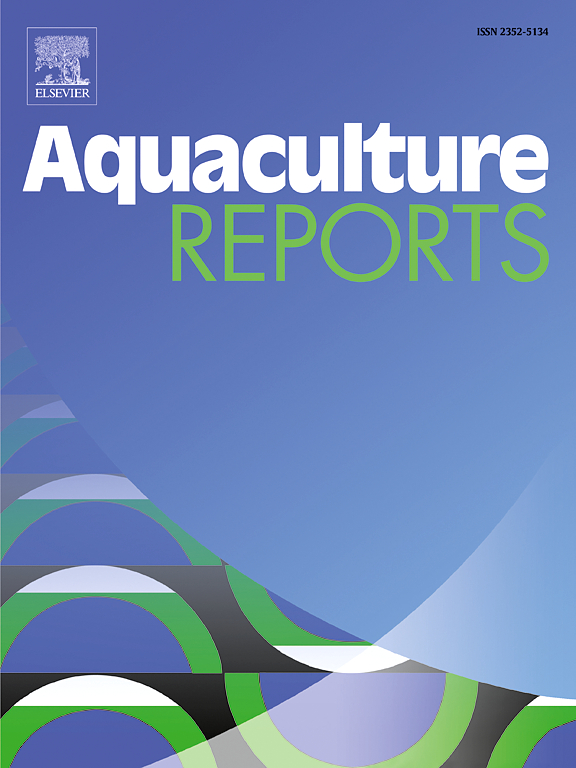从生长性能、氨基酸组成、抗氧化能力和内质网应激等方面评价马尾藻酶解与鱼蛋白水解产物混合作为对虾饲料中替代蛋白质源的效果
IF 3.2
2区 农林科学
Q1 FISHERIES
引用次数: 0
摘要
本研究评价了马尾藻与鱼蛋白水解产物(本研究命名为“SFPH”)混合酶解作为虾饲料中鱼粉替代品的效果。对初始体重为0.9 g的凡纳滨对虾饲喂6种等氮等脂饲料(SFPH分别替代0 %、5 %、10 %、20 %、30 %和40 %的鱼粉蛋白),持续8周。结果表明,SFPH可替代30% %的鱼粉,且不影响对虾的生长性能。而40% %的SFPH替代显著抑制了对虾的增重率和特定生长率。SFPH替代对虾体脂肪酸组成影响不大,但显著降低了虾体中组氨酸、苯丙氨酸、酪氨酸和牛磺酸的含量。当替代不超过20% %的鱼粉时,SFPH改善了虾肝胰脏和肌肉的结构。然而,40% %的SFPH替代显著破坏了肝胰腺和肌肉的结构。SFPH取代显著影响了其抗氧化能力,表现为T-AOC活性逐渐降低。内质网应激方面,30 %SFPH组和40 %SFPH组显著提高了eif2α和bip mRNA的表达。综上所述,SFPH可替代对虾饲料中30% %的鱼粉蛋白,而不影响对虾的生长。但当SFPH超过30% %时,极易诱发肝胰腺氧化应激和内质网应激。本文章由计算机程序翻译,如有差异,请以英文原文为准。
Evaluation of the enzymatic hydrolysis of sargassum mixed with fish protein hydrolysis product as an alternative protein source in shrimp feed, from the perspectives of growth performance, amino acid composition, antioxidant capacity and endoplasmic reticulum stress
A study was conducted to evaluate the effect of enzymatic hydrolysis of sargassum mixed with fish protein hydrolysis product (named “SFPH” in the present study) as a substitute for fish meal in shrimp feed. Six isonitrogenous and isolipidic diets (SFPH was used to replace 0 %, 5 %, 10 %, 20 %, 30 % and 40 % of fish meal protein) were administered to Litopenaeus vannamei (initial body weight: 0.9 g) for 8 weeks. Results showed that SFPH can replace 30 % of fish meal without affecting the growth performance of shrimp. However, 40 % of SFPH substitution significantly inhibited the weight gain rate (WGR) and specific growth rate (SGR) of shrimp. SFPH substitution had little effect on the composition of fatty acids, but SFPH substitution significantly reduced the contents of histidine, phenylalanine, tyrosine and taurine in the whole shrimp body. SFPH improved the structure of shrimp hepatopancreas and muscle when no more than 20 % of the fish meal was replaced. However, 40 %SFPH substitution significantly disrupted the structure of hepatopancreas and muscle. SFPH substitution significantly affected the antioxidant capacity, as manifested by a gradual decrease in T-AOC activity. With respect to endoplasmic reticulum stress, 30 %SFPH and 40 %SFPH groups significantly increased the mRNA expression of eif2α and bip. In summary, SFPH can replace 30 % of fish meal protein in shrimp feed without affecting shrimp growth. However, when SFPH exceeds 30 %, it can easily induce oxidative stress and endoplasmic reticulum stress in the hepatopancreas.
求助全文
通过发布文献求助,成功后即可免费获取论文全文。
去求助
来源期刊

Aquaculture Reports
Agricultural and Biological Sciences-Animal Science and Zoology
CiteScore
5.90
自引率
8.10%
发文量
469
审稿时长
77 days
期刊介绍:
Aquaculture Reports will publish original research papers and reviews documenting outstanding science with a regional context and focus, answering the need for high quality information on novel species, systems and regions in emerging areas of aquaculture research and development, such as integrated multi-trophic aquaculture, urban aquaculture, ornamental, unfed aquaculture, offshore aquaculture and others. Papers having industry research as priority and encompassing product development research or current industry practice are encouraged.
 求助内容:
求助内容: 应助结果提醒方式:
应助结果提醒方式:


